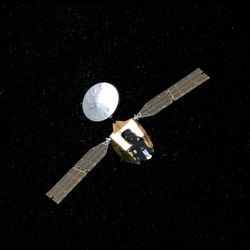Artist's concept of Mars Reconnaissance Orbiter. Image credit: NASA/JPL.
Click to enlarge
NASA's Mars Reconnaissance Orbiter successfully fired six engines for about 20 seconds today to adjust its flight path in advance of its March 10, 2006, arrival at the red planet.
Since its Aug. 12 launch, the multipurpose spacecraft has covered about 60 percent of the distance for its trip from Earth to Mars. It will fly about 40-million kilometers (25-million miles) farther before it enters orbit around Mars. It will spend half a year gradually adjusting the shape of its orbit, then begin its science phase. During that phase, it will return more data about Mars than all previous missions combined. The spacecraft has already set a record transmission rate for an interplanetary mission, successfully returning data at 6 megabits per second, fast enough to fill a CD-ROM every 16 minutes.
"Today's maneuver mainly increases the speed to bring us to the target point at just the right moment," said Tung-hanYou, chief of the Mars Reconnaissance Orbiter navigation team at NASA's Jet Propulsion Laboratory, Pasadena, Calif. The intended nudge in velocity is 75 centimeters per second (less than 2 miles per hour). The spacecraft's speed relative to the sun is about 27 kilometers per second (61,000 miles per hour).
Four opportunities for course adjustments were planned into the schedule before launch. Today's, the second, used only the trajectory-correction engines. Each engine produces about 18 newtons (4 pounds) of thrust. The first course adjustment, on Aug. 27, doubled as a test of the six main engines, which produce nearly eight times as much thrust. Those main engines will have the big job of slowing the spacecraft enough to be captured into orbit when it reaches Mars. The next scheduled trajectory adjustment, on Feb. 1, 2006, and another one 10 days before arrival will be used, if necessary, for fine tuning, said JPL's Allen Halsell, the mission's deputy navigation chief.
The Mars Reconnaissance Orbiter mission will examine Mars in unprecedented detail from low orbit. Its instrument payload will study water distribution -- including ice, vapor or liquid -- as well as geologic features and minerals. The orbiter will also support future missions to Mars by examining potential landing sites and by providing a high-data-rate relay for communications back to Earth.
The mission is managed by JPL, a division of the California Institute of Technology, Pasadena, for the NASA Science Mission Directorate. Lockheed Martin Space Systems, Denver, is the prime contractor for the project and built the spacecraft.
For information about the Mars Reconnaissance Orbiter on the Web, visit
http://www.nasa.gov/mro
. For information about NASA and agency programs on the Web, visit http://www.nasa.gov/home/index.html
.
NASA News Release
 Universe Today
Universe Today
